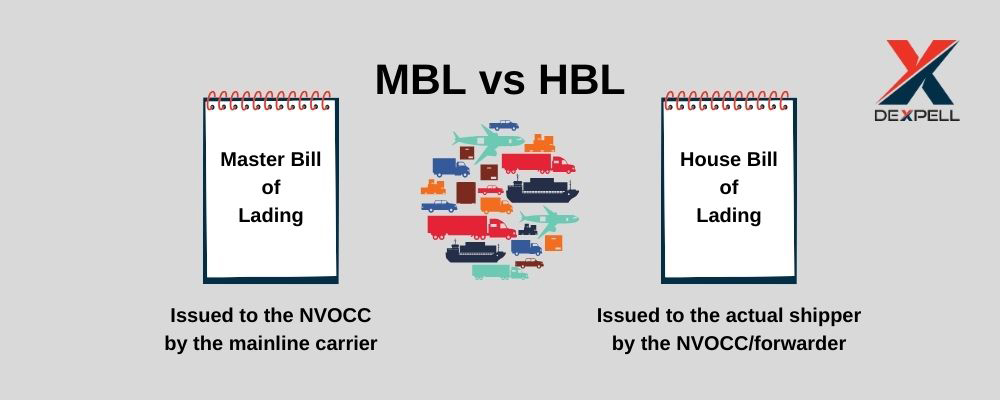Understanding the Bill of Lading
A Bill of Lading is a crucial document in the shipping industry, serving multiple purposes:
It outlines the cost or price of goods and services.
"Lade" refers to the act of loading cargo onto a ship or other modes of transport.
Essentially, it records the goods loaded onto a ship, acting as a contract and receipt between the carrier (or transport company) and the shipper.
The Bill of Lading includes vital information such as:
The shipper/exporter's and consignee/importer's details (name, address, and zip code).
Freight forwarder's details.
Incoterms, Bill of Lading number, carrier details (including name and voyage number).
Freight charge terms, customer order information/shipment details, and the carrier's signature and date.
Master Bill of Lading (MBL)
The Master Bill of Lading, abbreviated as MBL, is issued by the ship's Master to Non-vessel Operating Common Carriers (NVOCC), freight forwarders, or direct customers of the shipping line. It includes shipment details and serves as proof of cargo receipt by the carrier.
Issuer: The carrier or shipping line's master.
Recipients: NVOCCs, freight forwarders, or the carrier's direct customers.
House Bill of Lading (HBL)
Conversely, the House Bill of Lading (HBL) is a document issued by NVOCC operators or freight forwarders to their customers.
Issuer: NVOCCs or freight forwarders.
Purpose: Acts as a receipt of cargo shipment.
Key Differences Between MBL and HBL
Although HBL mirrors the relevant details found in MBL, it specifically varies in the shipper, consignee, and notify party details:
HBL lists the actual shipper/exporter and the actual importer/receiver as the consignee, with the notify party potentially being the same as the consignee or a different entity.
MBL is issued to NVOCC operators or freight forwarders, with the consignee typically being the destination agent or office.
Summary of Similarities and Differences
Both documents share details like vessel and voyage information, weight, measurements, and container numbers. However, while the House B/L represents a single shipper's cargo, the Master B/L can consolidate shipments from multiple exporters/shippers, facilitated by NVOCCs or freight forwarders.
Understanding the distinctions and applications of MBL and HBL is fundamental for those navigating the complexities of shipping logistics.
A Bill of Lading is a crucial document in the shipping industry, serving multiple purposes:
It outlines the cost or price of goods and services.
"Lade" refers to the act of loading cargo onto a ship or other modes of transport.
Essentially, it records the goods loaded onto a ship, acting as a contract and receipt between the carrier (or transport company) and the shipper.
The Bill of Lading includes vital information such as:
The shipper/exporter's and consignee/importer's details (name, address, and zip code).
Freight forwarder's details.
Incoterms, Bill of Lading number, carrier details (including name and voyage number).
Freight charge terms, customer order information/shipment details, and the carrier's signature and date.
Master Bill of Lading (MBL)
The Master Bill of Lading, abbreviated as MBL, is issued by the ship's Master to Non-vessel Operating Common Carriers (NVOCC), freight forwarders, or direct customers of the shipping line. It includes shipment details and serves as proof of cargo receipt by the carrier.
Issuer: The carrier or shipping line's master.
Recipients: NVOCCs, freight forwarders, or the carrier's direct customers.
House Bill of Lading (HBL)
Conversely, the House Bill of Lading (HBL) is a document issued by NVOCC operators or freight forwarders to their customers.
Issuer: NVOCCs or freight forwarders.
Purpose: Acts as a receipt of cargo shipment.
Key Differences Between MBL and HBL
Although HBL mirrors the relevant details found in MBL, it specifically varies in the shipper, consignee, and notify party details:
HBL lists the actual shipper/exporter and the actual importer/receiver as the consignee, with the notify party potentially being the same as the consignee or a different entity.
MBL is issued to NVOCC operators or freight forwarders, with the consignee typically being the destination agent or office.
Summary of Similarities and Differences
Both documents share details like vessel and voyage information, weight, measurements, and container numbers. However, while the House B/L represents a single shipper's cargo, the Master B/L can consolidate shipments from multiple exporters/shippers, facilitated by NVOCCs or freight forwarders.
Understanding the distinctions and applications of MBL and HBL is fundamental for those navigating the complexities of shipping logistics.










